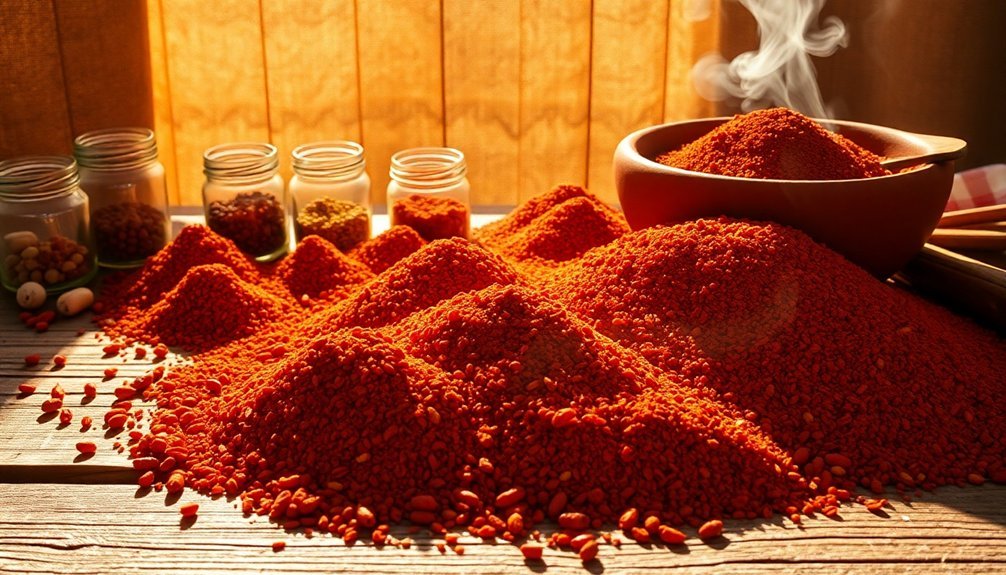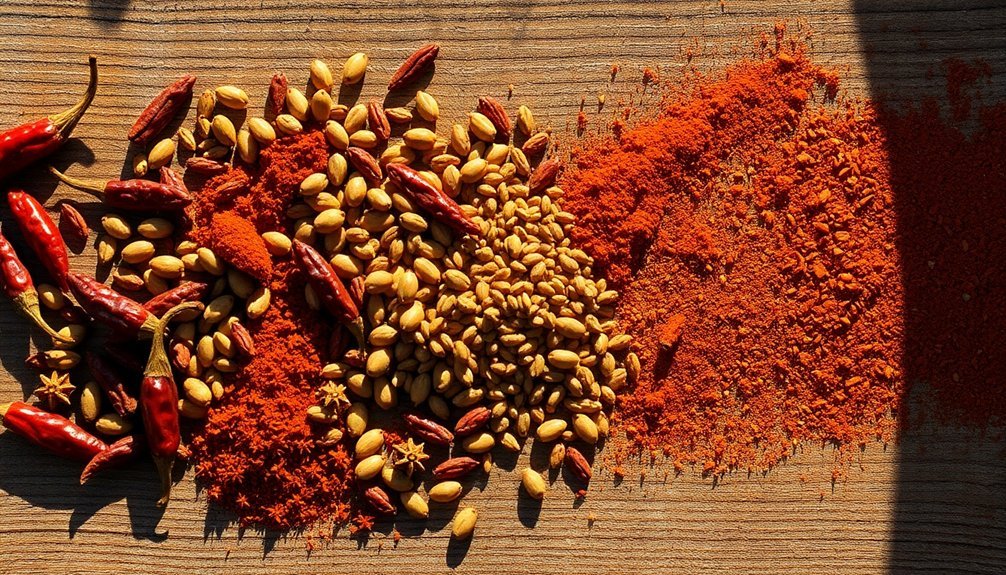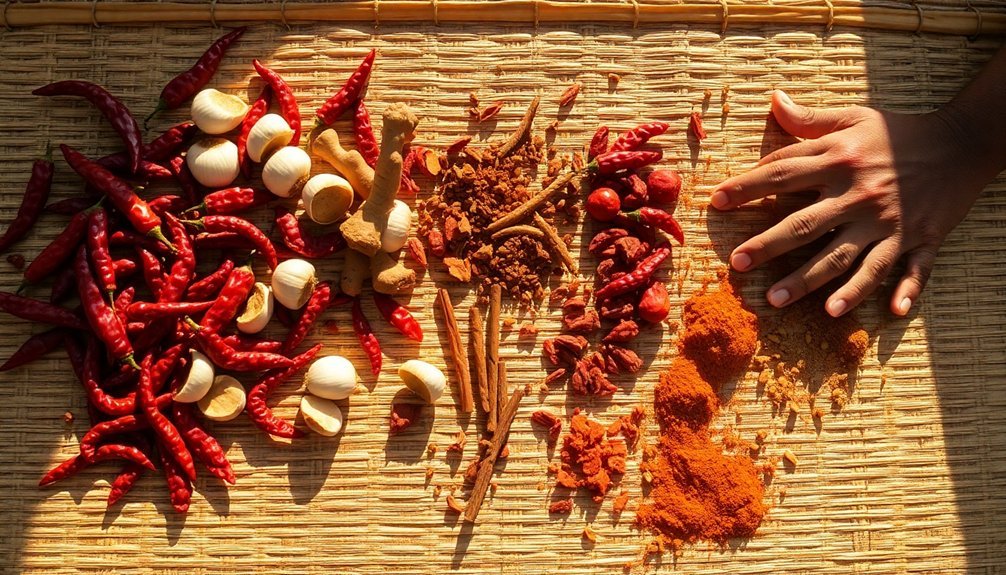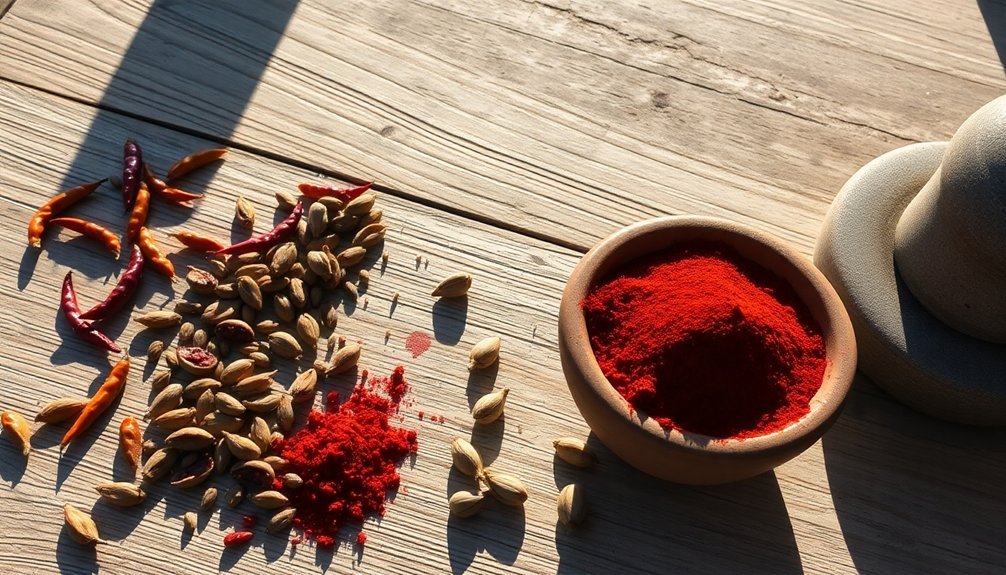You'll discover five authentic ways to enhance berbere spice blend using Africa's natural heat. Start by solar-roasting whole spices in UV-stable containers, positioning them to follow the sun's path. Try layering herbs in sun pots using the thriller-filler-spiller method for fresh ingredients. Master traditional dry-heat toasting techniques in a heavy pan or oven for maximum flavor release. Create solar-infused oils by combining spices with carrier oils in glass jars under direct sunlight. Finally, sun-dry fresh ingredients on ventilated racks covered with cheesecloth. These time-tested Ethiopian methods will open your eyes to the ancient art of spice crafting.
Solar Roasted Berbere Blend

Three key elements make solar roasted Berbere blend uniquely flavorful: traditional Ethiopian spices, precise toasting techniques, and the natural heat of the sun.
You'll need paprika, chili powder, garlic powder, coriander, cumin, fenugreek, and warming spices like nutmeg and cinnamon.
To create your solar-roasted blend, spread whole spices on a heat-resistant, UV-stable container and position it to maximize sun exposure. This method pairs perfectly with meal planning options for creating flavorful dishes throughout the week.
Monitor the spices carefully as they toast, adjusting the container's position as the sun moves.
You'll know they're ready when their aromatic oils release a rich fragrance.
Once toasted, grind the spices in a high-speed blender or food processor.
Store your finished blend in an airtight container in the refrigerator to maintain its vibrant flavors.
Layering Spices In Sun Pots
Building on the concept of solar-roasted spices, you can create a vibrant herb garden that brings fresh flavors to your Berbere blend.
When planting sun-loving herbs, you'll want to use the thriller-filler-spiller method in containers at least a foot wide. Arrange Mediterranean herbs like oregano, thyme, and sage in well-draining soil, ensuring they get 5-6 hours of direct sunlight. Regular pruning of these herbs will encourage bushier growth and prevent overcrowding in your containers.
- Position taller herbs like rosemary in the center as your "thriller," creating a dramatic focal point.
- Surround the center with "filler" herbs such as thyme and oregano, which complement each other's growing needs.
- Let trailing herbs cascade over the pot's edge as "spillers," maximizing your growing space.
Remember to water moderately, letting the soil dry slightly between waterings to mimic their natural Mediterranean habitat.
Dry Heat Toasting Methods

When preparing authentic Berbere spice blend, mastering dry heat toasting techniques will reveal deeper, more complex flavors in your spices. You'll find two effective methods: pan toasting and oven roasting.
For pan toasting, heat a heavy-based pan over medium heat, add your whole spices, and stir constantly until they're fragrant. Maintaining constant movement helps distribute heat evenly and prevents the spices from burning. You'll want to watch for slight color changes in coriander, cumin, and cardamom. Remove them immediately to prevent burning.
If you prefer oven roasting, preheat to 350°F and spread your spices on a rimmed baking sheet. Cover with another sheet for uniform heating, and check after 2-3 minutes. The process typically takes 5-8 minutes total.
Both methods release essential oils, reduce moisture, and enhance the spices' flavors – vital elements for your Berbere blend.
African Solar Infusion Techniques
Traditional African infusion methods harness the intense equatorial sun to create richly flavored oils and essences.
You'll discover that solar-infused berbere oils carry deeper, more complex flavors than their conventional counterparts. By selecting jojoba or sunflower oil as your base, you're creating an ideal foundation for berbere's distinctive spices. For optimal preservation, store your finished infusions in dark glass containers.
- Place your dried berbere spices in a clear glass jar, covering them with your chosen carrier oil until they're submerged with an inch of headspace.
- Position your jar where it'll catch direct sunlight during peak hours, typically on a sunny windowsill.
- Shake your infusion daily for 2-4 weeks, watching as the oil gradually takes on the rich, reddish-brown hue of berbere.
After straining through cheesecloth, you'll have a versatile, sun-kissed oil that's perfect for marinades and finishing touches.
Sun Drying Fresh Ingredients

The art of sun-drying fresh ingredients takes berbere preparation to new heights, complementing our solar-infused oils perfectly.
You'll want to select unblemished, ripe vegetables and spice ingredients that are cut into uniform, smaller pieces for consistent drying.
Before laying your ingredients on drying racks, wash them thoroughly and treat them with lemon juice to prevent browning.
Place your trays in a hot, sunny spot with good airflow, and don't forget to cover them with cheesecloth to keep pests away.
Your ingredients will need one to three days to dry properly. You'll know they're ready when they're slightly flexible but not moist.
Once dried, store your berbere ingredients in airtight glass containers in a cool, dark place to maintain their vibrant flavors and aromatic properties.
Frequently Asked Questions
Can Berbere Spice Blend Cause Allergic Reactions in People With Nut Sensitivities?
You shouldn't experience nut allergy reactions from berbere, as it doesn't contain nuts. While you might have other spice sensitivities, the blend isn't known to trigger reactions in people with nut allergies.
How Does Altitude Affect the Solar Roasting Time of Berbere Spices?
At higher altitudes, you'll need to extend your berbere roasting time due to lower air density. You should add 5-10 minutes per 1,000 feet elevation to compensate for faster moisture evaporation.
What Traditional Ethiopian Tools Are Used for Grinding Sun-Dried Berbere Ingredients?
You'll typically use a traditional mortar and pestle to break down sun-dried chilies, while a spice grinder helps create finer powders. A coffee mill and specialized spice mills are also common grinding tools.
Does Moonlight Exposure Affect the Potency of Solar-Roasted Berbere Spices?
You won't notice any significant impact from moonlight on your solar-roasted berbere's potency. While moonlight affects living plants, it doesn't influence dried spices. Focus instead on proper storage to maintain your berbere's strength.
Can Berbere Be Solar-Processed During Rainy Season Using Alternative Methods?
You can process berbere during rainy season by using plastic sheets, concrete floors, or covered areas. It's best to combine indoor drying with sorting techniques to maintain quality despite limited sun exposure.
In Summary
You've discovered how to harness the African sun's intense heat to create vibrant berbere blends. Whether you're solar roasting whole spices, layering ingredients in traditional clay pots, or dry-toasting your mix, you'll get that authentic Ethiopian depth of flavor. Don't forget to try sun-drying fresh chilies and herbs – it's a game-changer. Your homemade berbere will bring that unmistakable East African warmth to every dish.





Leave a Reply